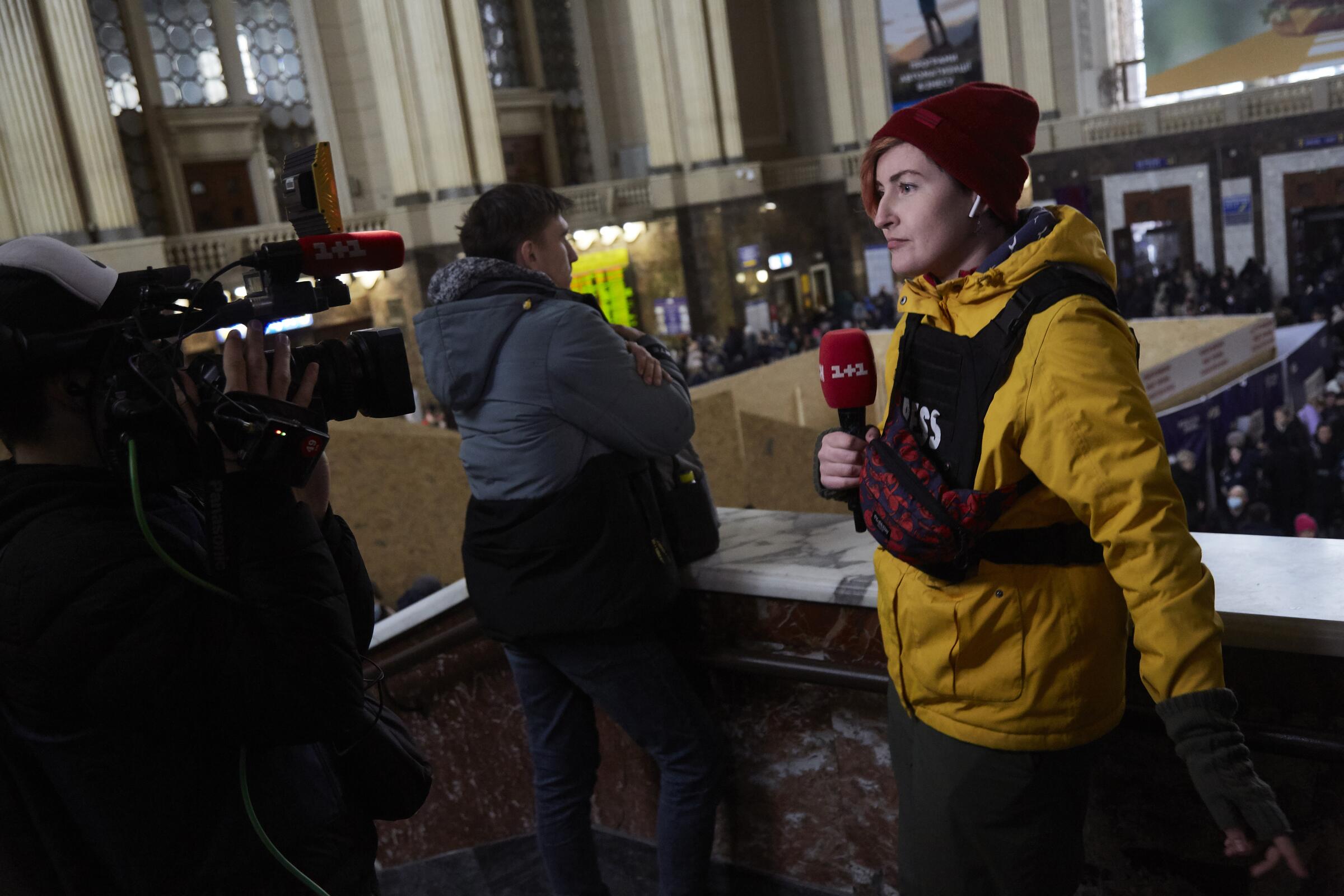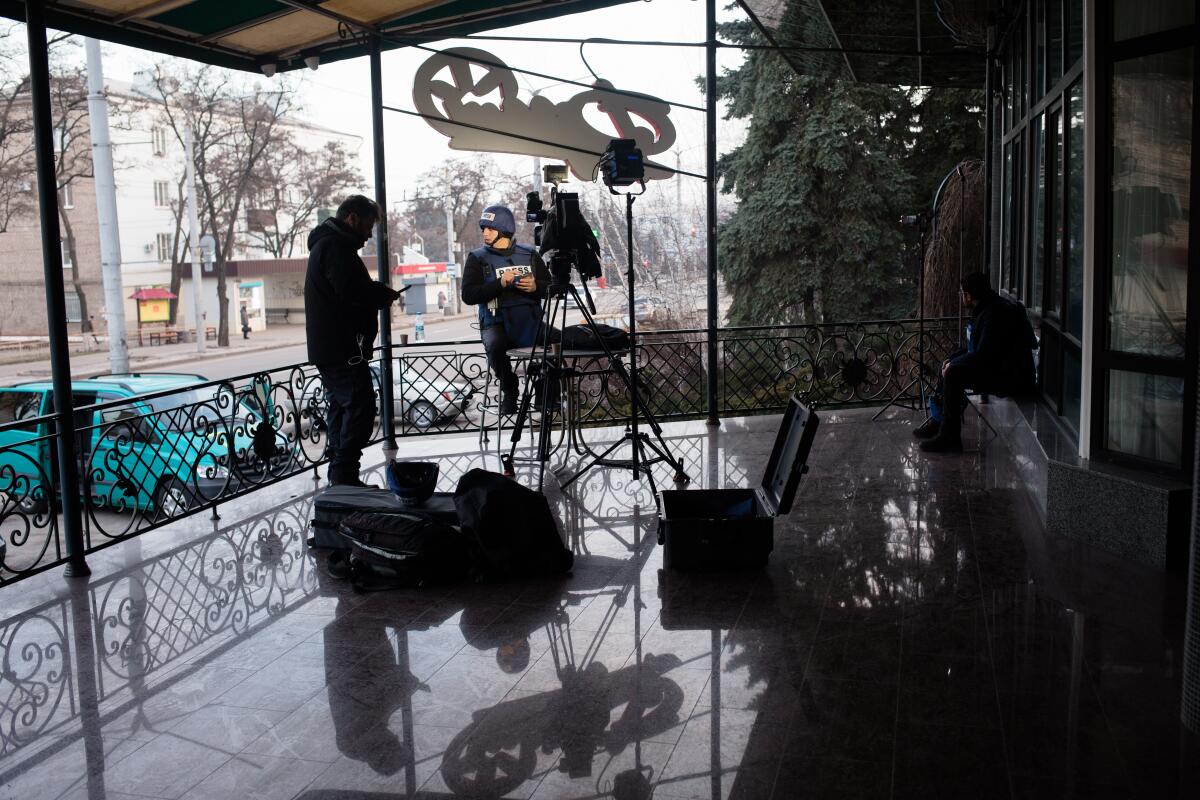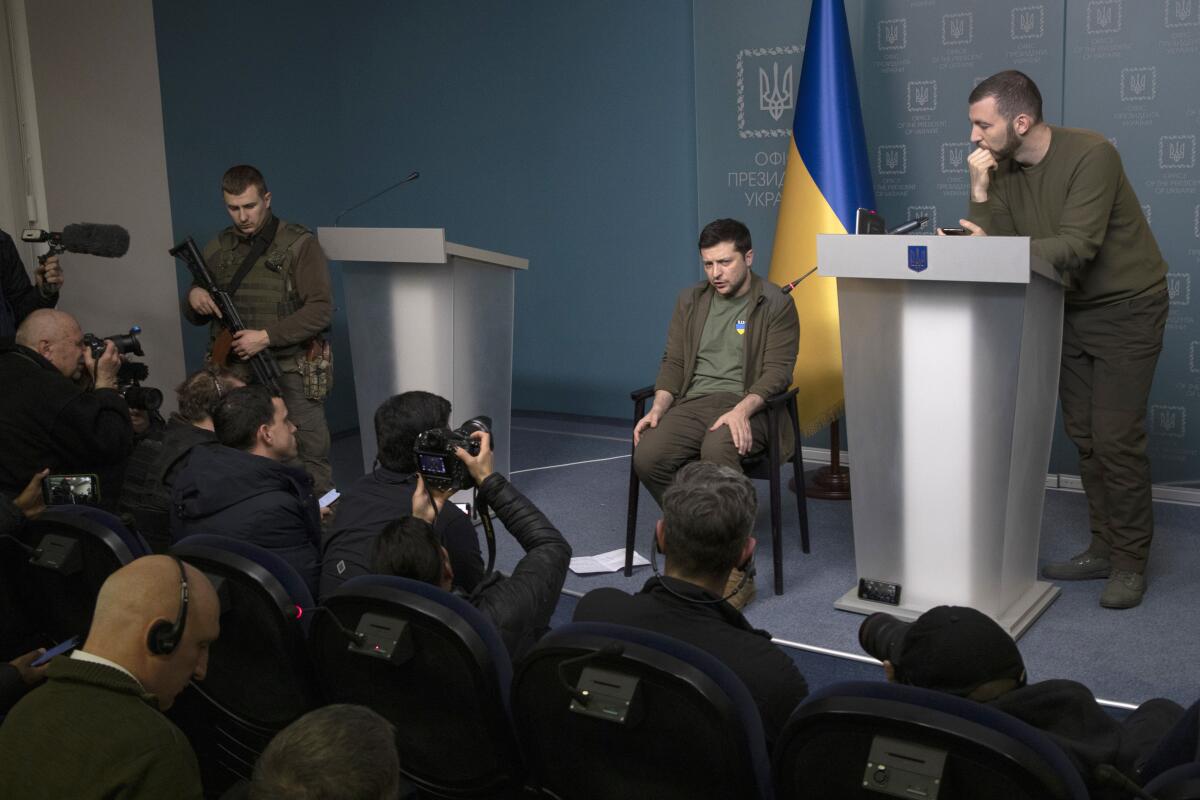The complete guide to home viewing
Get Screen Gab for everything about the TV shows and streaming movies everyone’s talking about.
You may occasionally receive promotional content from the Los Angeles Times.

Weaponizing all manner of media is a specialty of Vladimir Putin’s, but now, two weeks into his unprovoked attack on Ukraine, Russia’s president is losing the information war.
Putin’s foreign minister, Sergei Lavrov, drove the point home Thursday when he claimed, absurdly, that Russia had not attacked Ukraine at all. But that was just the latest, if most pointedly Orwellian, in Russia’s bizarre missteps as it has tried, and failed, to control the narrative of the war.
On Wednesday, the City Council of the southern Ukrainian city of Mariupol posted video of a devastated children’s and maternity hospital, claiming Russian forces bombed it from the air. The report was picked up by outlets around the globe, and journalists arrived on the scene, accelerating the story’s spread on social media and adding to a mountain of visual and audio evidence — images of dead Ukrainian families, the sounds of crying Russian soldiers — that has reaffirmed Putin’s status as an unstable strongman, geopolitical pariah and deadly thug.
When newspaper columnists and TV correspondents express shock at European conflict, they reveal a damning belief that war is acceptable elsewhere.
It’s not the propaganda campaign the Kremlin envisioned on the eve of its Feb. 24 attack on the Eastern European country, when Putin characterized the invasion as a “special operation” launched to save Ukrainians from the “band of junkies and neo-Nazis” that was their government. The false claim would have been laughable if deceptive messaging, red herrings and false flags weren’t deadly weapons in Putin’s arsenal, used to redirect attention as Russia waged wars on- and offline — or invaded a neighboring country. But this time around, Moscow’s attempts to cloud the picture have been thwarted.
Instead, the Ukrainian people and an army of international journalists are there to counter the spin, bearing witness to Russian aggression (bombing residential buildings, targeting refugee corridors) and civilian resistance with a speed and ferocity that has outpaced, and in many cases overshadowed, Moscow’s disinformation campaign. Their tenacity and bravery, and the vast resources news outlets are allocating to cover the war, are breaking a propaganda machine that — while not the only one of its kind on the global stage — appeared too practiced and successful to fail.

After all, Russia under Putin has been masterful at promulgating its message and obfuscating the facts, in the fog of war and the heat of elections alike. The former Soviet state ginned up false flag operations ahead of its 2014 seizure of Crimea and its 2015 military intervention in the Syrian civil war, then made the conflicts appear so complicated that many observers found them too tangled to unravel. For example, pro-Russian and Syrian agents launched an online conspiracy campaign linking the humanitarian rescue group known as the White Helmets (officially the Syria Civil Defence) with Al Qaeda. The claim gained traction in the West, even as Russian forces, allied with Syrian dictator Bashar Assad, perpetrated horrific war crimes against the region’s population.
Muddling the story in Syria — Who’s the peacekeeper? Who’s the terrorist? — allowed for widespread shock and surprise when Russia began killing women and children on the ground in Ukraine, but sadly, the scenes of a bloodied child’s mattress or rows of corpses in mass graves were all too common in the war in Syria. Russia was just adept at hiding its complicity, and, blinded by Putin’s distortions, the West often viewed the destruction “over there” as part of nonstop conflict in the region. A tragedy, yes, but one that would never touch Christian Europe.
Russia also sowed division during Brexit and, most prominently, the 2016 race for the U.S. presidency. But Donald Trump and his supporters, who were singing Putin’s praises just weeks ago, tempered their words or changed their tune altogether once live reporting began pouring in from Ukraine. Under the disinfecting spotlight of an engaged international press, cheerleading for Vlad suddenly became too depraved, even for Tucker Carlson.
Along with Fox News host Laura Ingraham, Carlson has downplayed Russian aggression against Ukraine and NATO. Thursday, he tried to change his tune.
That Putin, the supposed evil genius, has fumbled the media war so soon in the conflict points to one of the key differences in this war, as opposed to other conflicts and attacks: He wasn’t able to plan in the dark. The Biden administration alerted the world of Russia’s invasion plans well in advance so that, by early February, Kyiv and environs were full of international journalists and camera crews anticipating the strikes. Ukraine was open to global press, so networks didn’t have to rely as heavily on their Moscow bureaus as they had in the past for breaking news out of the surrounding region. Now, they’re not even reporting on Russia from inside Russia.
The Russian government has shut down remaining independent media outlets, restricted social media and imposed new legislation that threatens a lengthy prison sentence for journalists who dare to describe the attack on Ukraine as a “war.” Now, several Western media organizations have suspended operations in Russia because of the crackdowns.
Russian President Vladimir Putin intensified a crackdown on media outlets blocking Facebook and Twitter and signing into law a bill that criminalizes what Moscow deems to be “fake” reports.
Facebook and Twitter have taken steps to remove Russian and Belarusian disinformation, or label it as such. The cyber offensives started weeks before the invasion, replete with computer-generated users sharing the work of fake anti-Ukraine columnists across platforms. (According to a recent report from ProPublica, though, fact-checking sites that claim to debunk doctored Russian video are themselves part of “a novel and disturbing campaign that spreads disinformation by disguising it as fact-checking.”) State TV network RT (formerly Russia Today), banned in Ukraine since 2014, is now banned through the EU, and its American arm recently shuttered.
The current failings of Putin’s vaunted disinformation apparatus don’t mean that Russia won’t find a way to pull ahead in the PR war, achieve its military aims in Ukraine or continue to inflict untold devastation in the region. But they didn’t anticipate an army of Ukrainians and international reporters in their path, ready to tell another story.
The whole world is watching.

The complete guide to home viewing
Get Screen Gab for everything about the TV shows and streaming movies everyone’s talking about.
You may occasionally receive promotional content from the Los Angeles Times.